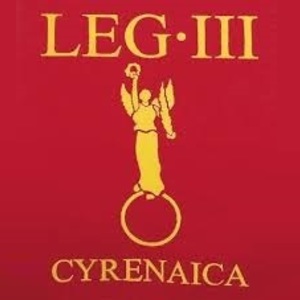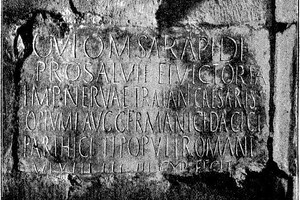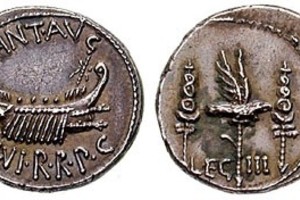Roman Legion - Legio III Cyrenaica
Legio III Cyrenaica (Third Cyrenaican Legion) was a Roman legion formed by Marcus Lepidus to hold Cyrenaica.
Dates of existence: 36 BC to the 5th century AD
Symbol: Unknown, possibly a lion or Victoria.
Nickname: Cyrenaica (Cyrenaican), later Claudiana, Severiana, Valeriana, Galliena.
Battle Path
The exact date of the legion's creation is unknown, with four prevailing theories:
1) Some authors believe the legion was created by Marcus Lepidus, a member of the Second Triumvirate, in 36 BC when he was governing Cyrenaica.
2) Others think the legion was formed by Mark Antony when he was governor of Cyrenaica around 36 BC.
3) Another group suggests the legion was created before 30 BC and, after participating in the conquest of Egypt, was stationed in Cyrenaica.
4) Emperor Octavian may have named the legion for its operations in that region.
- Cyrenaica is a historical region in Libya. Since 74 BC, Cyrenaica was a Roman province, later merged with Crete in 27 BC into the province of Crete and Cyrenaica, governed by the Senate. Regardless of its origins, it is agreed that this legion is one of the oldest Republican legions incorporated into the Imperial Roman army. It is known that the legion participated in Octavian's Egyptian campaign and remained stationed in Egypt for nearly a century and a half. Initially, its camp was likely in Upper Egypt (probably in Thebes), with parts of the legion also stationed in Berenike (modern Benghazi, Libya), the capital of Cyrenaica. The legion likely participated in the military campaign in Arabia (the Aelius Gallus campaign) and punitive expeditions to the city of Meroë (an ancient city in modern Sudan) for its attacks on Upper Egypt in the 20s BC.
- From 7 to 35 AD, the legion was stationed, along with the Legio XXII Deiotariana,, in a double camp in the suburb of Alexandria, Nicopolis. Parts of the 3rd Cyrenaican Legion were stationed throughout Egypt, engaging in construction and security duties.
- In 38 AD, the legion's units suppressed anti-Jewish riots in Egypt.
- In 39-40 AD, a vexillation of the legion was sent to the northern coast of Gaul for participation in the invasion of Britain during Emperor Caligula's reign. The invasion did not occur, and the vexillation returned to Egypt.
- In 63 AD, parts of Legio III Cyrenaica participated in Rome's war with Parthia over Armenia, commanded by Gnaeus Corbulo.
- During Emperor Nero's reign (54-68 AD), the legion was known as the Third Cyrenaican Legion Claudia.
- During the First Jewish War (66-73 AD), the legion subdued the Jewish population in Egypt and Alexandria.
- After Emperor Nero's death in 68 AD, the legion supported Vespasian in 69 AD, sending a large detachment to his son Titus, which participated in the siege and storming of Jerusalem in 70 AD, then returned to Egypt.
- In the struggle for the imperial throne that began after the death of Emperor Nero in 68, the legion supported Vespasian in 69 and sent his son Titus a large detachment. This unit took part in the siege and storming of Jerusalem in 70 AD, and then returned to Egypt again.
- In 107-109 AD, the legion was temporarily removed from Egypt to be stationed in the newly acquired province of Arabia Petraea (modern Jordan, southern Syria, Sinai Peninsula, and northwestern Saudi Arabia). The legion occupied the capital of the new province, Bostra (modern Bosra in southern Syria), and deployed units across the province, such as in the city of Gerasa (today Jarash in northern Jordan).
- From 111 to 114 AD, the legion repaired or rebuilt the road from Bostra to the Red Sea (Via Traiana Nova) and a chain of forts and fortifications collectively forming the Arabian Limes. Shortly thereafter, the legion was returned to Egypt, as by 115 AD, it, along with the Twenty-Second Deiotariana Legion, was needed to suppress the Jewish uprising in Egypt and Cyrenaica. The uprising was quelled by 117 AD with reinforcements. Concurrently, a vexillation of the legion fought in Judea (116 AD) and participated in Emperor Trajan’s Parthian campaign (117 AD).
- In 120 AD, the legion fought against Arab tribes. Between 120 and 125 AD, Legio III Cyrenaica was withdrawn from Egypt and permanently stationed in Bostra.
- A vexillation of the legion participated in suppressing the Bar-Kokhba revolt in Judea (132-136 AD). During Emperor Antoninus Pius's reign (138-161 AD), Legio III Cyrenaica vexillations were sent to Mauretania to fight against the Moors, while other parts were stationed in Hegra (modern Mada'in Saleh, northwest Saudi Arabia).
- During Emperor Antoninus Pius's reign (138-161 AD), Legio III Cyrenaica vexillations were sent to Mauretania to fight against the Moors, while other parts were stationed in Hegra (modern Mada'in Saleh, northwest Saudi Arabia).
- From 162 to 166 AD, parts of the legion took part in Lucius Verus's Parthian campaign (the war between Rome and Parthia over Armenia and Mesopotamia).
- In 175 AD, during the rebellion of Avidius Cassius against Emperor Marcus Aurelius, the legion supported the usurper Avidius but was defeated. Due to their support for Avidius, parts of the legion likely participated in the Marcomannic War.
- In the year of the Five Emperors (193 AD), the legion supported Pescennius Niger but lost to another contender for the imperial throne, Septimius Severus, in 194 AD. This possibly led to the legion's participation in Severus's war with Parthia over Mesopotamia.
- In the early 3rd century (216-217 AD), the legion participated with other legions in Emperor Caracalla's Parthian campaign.
- In 216 AD, Legio III Cyrenaica soldiers, along with Legio IV Scythica forces, built an amphitheater in Dura-Europos (now an ancient ruin near the modern Syrian city of Salhiyah).
- In the 230s, the legion participated in Emperor Alexander Severus’s Persian campaign in Mesopotamia, for which Emperor Severus granted the legion the honorary title "Alexander Severus's Legion." Later, the legion received the title "Valerian’s Legion" during Emperor Valerian’s reign (253-260 AD) and "Gallienus’s Legion" during Emperor Gallienus’s reign (253-268 AD).
- From 262-273 AD, the legion fought first with Queen Zenobia of Palmyra against Persia, then against her when she declared Palmyra independent from Rome. Palmyra was a client state of Rome from 260 to 273 AD, encompassing the territories of the Roman provinces of Syria, Palestine, Egypt, and much of Southern Armenia, with its capital in the city of Palmyra (modern Syria). After subjugating Palmyra, Legio III Cyrenaica, along with Legio IIII Martia forces, was stationed in the province of Arabia.
- In the early 5th century, Legio III Cyrenaica is mentioned in the Notitia Dignitatum. According to this document, the legion was stationed in Bostra and commanded by Dux of Arabia.
Related topics
List of Roman Legions, Legion, Legionnaire,Marcus Aemilius Lepidus, Octavian Augustus, Mark Antony, Legio XXII Deiotariana, Year of the Four Emperors, Marcus Ulpius Nerva Trajan, Notification Dignitatum, Dux
Literature
- Collins Dando - Complete History of Roman Legions
- R. Kanya. A Brief History of Various Legions. Legio. 2001
- Jona Lendering. Legio III Cyrenaica (Engl.). Livius.org. 2002
- P.-L. Gatier, "La Legio III Cyrenaica et l'Arabie", in Les Legions de Rome sous le Empire, I, Lyon, 2000, pp. 341-344





